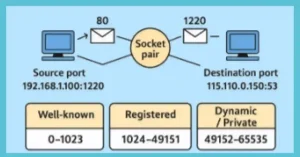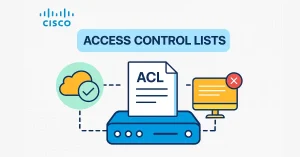Carrier Sense Multiple Access (CSMA) is a network protocol that listens for a carrier signal before transmitting data, reducing collisions on shared transmission media like Ethernet and Wi-Fi networks. By checking the state of the medium before sending, CSMA ensures efficient data transmission in networks with multiple devices. As part of the Media Access Control (MAC) protocol, CSMA is critical in modern networking, including Wi-Fi 6/7 and legacy Ethernet systems.
What is Carrier Sense Multiple Access/Collision Detection (CSMA/CD)
Carrier Sense Multiple Access/Collision Detection (CSMA/CD) is a transmission method historically used in half-duplex Ethernet networks. Here’s how it works:
- Carrier Sensing: Each device checks if the line is idle before sending a frame.
- Transmission: If the medium is clear, the device sends its frame.
- Collision Detection: If another device transmits simultaneously, a collision occurs, and both frames are discarded.
- Backoff Mechanism: Devices wait a random time before retrying, reducing further collisions.
CSMA/CD was widely used in early Ethernet but is less common today due to full-duplex Ethernet, which eliminates collisions.
What is Carrier Sense Multiple Access with Collision Avoidance (CSCMA/CA)
Carrier Sense Multiple Access/Collision Avoidance (CSMA/CA) is the standard access method for 802.11 Wi-Fi networks, including modern Wi-Fi 6 and 7. Unlike CSMA/CD, CSMA/CA is designed for wireless networks where collision detection is challenging due to low received signal energy (5-10% increase during collisions). Here’s how it operates:
- Carrier Sensing: The node checks if the channel is clear.
- Backoff Mechanism: If the channel is busy, the node waits a random period (backoff factor) before rechecking.
- Transmission Duration: Each device includes the time needed for transmission, informing others when the medium will be free.
- Transmission: The node sends the packet when the backoff counter reaches zero and the channel is clear.
CSMA/CA is critical for wireless networks, ensuring efficient channel access in crowded environments like offices or stadiums.
CSMA in Modern Networking (2025)
CSMA/CA remains essential in modern wireless networks, powering Wi-Fi 6 (802.11ax) and Wi-Fi 7 (802.11be), which are deployed in over 80% of enterprise networks by 2025. Its collision avoidance mechanism supports high-density environments, such as IoT ecosystems and 5 G-integrated networks. For example, in smart homes, CSMA/CA enables multiple IoT devices to share the same Wi-Fi channel without significant packet loss. Meanwhile, CSMA/CD is largely obsolete in modern full-duplex Ethernet but may still be found in legacy industrial systems.
Comparison of CSMA/CD and CSMA/CA
| Feature | CSMA/CD | CSMA/CA |
|---|---|---|
| Network Type | Wired (Ethernet) | Wireless (Wi-Fi) |
| Collision Handling | Detects and resolves collisions | Avoids collisions before transmission |
| Use Case | Legacy half-duplex Ethernet | Modern Wi-Fi (802.11ax/be) |
| Efficiency | Less efficient in high-traffic | Optimized for wireless environments |
| Status in 2025 | Largely obsolete | Widely used |
Why is CSMA Important?
CSMA protocols manage data transmission on shared networks, reducing collisions and improving efficiency. CSMA/CA’s proactive collision avoidance makes it ideal for wireless networks, while CSMA/CD’s historical role in Ethernet laid the foundation for modern networking standards.
FAQs
What is Carrier Sense Multiple Access (CSMA)?
Carrier Sense Multiple Access (CSMA) is a network protocol that listens for a carrier signal before transmitting data to avoid collisions on a shared transmission medium.
What are the variations of CSMA?
The main variations of CSMA are CSMA/CD (Collision Detection) and CSMA/CA (Collision Avoidance), each with different methods for managing data transmission and avoiding collisions.
How does CSMA/CD work?
CSMA/CD detects collisions during data transmission and stops the transmission immediately, then waits for a random period before attempting to retransmit.
What is the advantage of CSMA/CA over CSMA/CD?
CSMA/CA attempts to avoid collisions before they occur by using techniques like acknowledgment packets and time slots, making it more suitable for wireless networks.
Why is CSMA important in network communication?
CSMA helps manage data transmission on shared networks, reducing the likelihood of collisions and improving overall network efficiency.





